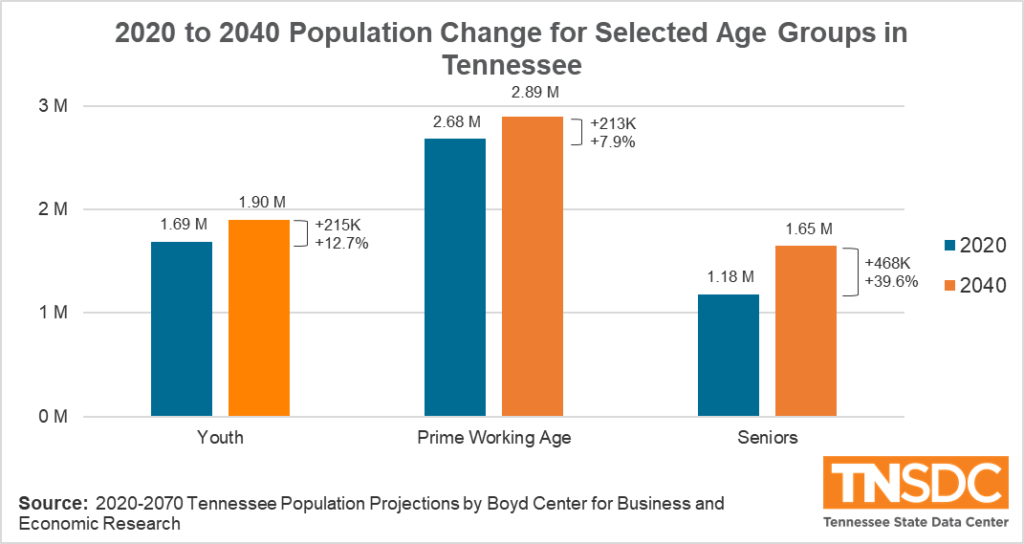Tennessee could grow by nearly a million people over the next 20 years and reach a total population of 7.87 million by 2040.
The Boyd Center for Business and Economic Research, housed in the Haslam College of Business at the University of Tennessee, Knoxville, released population projections this week that include data on age and race demographics for each of the state’s 95 counties from 2020 to 2070.

They show Tennessee’s population growing older and more diverse in the coming decades. By 2040, the state’s median age is projected to climb from 38.8 years to 40.7 years. This increase reflects growth among the state’s fastest growing age group: people 65 years and older.
An increase in the senior population is expected to push the number of retirement-aged people in the state from 1.18 million in 2020 to 1.65 million in 2040 — a nearly 40 percent increase. For comparison, the number of people under age 20 will grow only 13 percent over the same period and reach 1.9 million people.

Matt Harris, associate professor of economics and researcher for the Boyd Center population projections, noted that the senior population growth would account for roughly half (47.2 percent) of the state’s total projected increase over the next 20 years.
“Most of the growth in the senior population is driven by continued aging of the cohort born in the late 1950s and 1960s rather than by older individuals moving to Tennessee — although retirees moving to Tennessee does play a part,” Harris said.
The number of people in their prime working years, ages 25 to 54, is projected to increase at a slower pace than the state’s population as a whole. With an expected growth of just 7.9 percent among this group, the number of available workers could become a limitation on the state’s productivity. Harris also noted that the growing senior population could place additional constraints on the labor force as families balance employment and elder care responsibilities.
“As the number of seniors in Tennessee continues to increase, so will the number of individuals requiring care. Much of that care is provided by families, particularly in areas where there are not options for formal care — either in home or residential,” Harris said. “There is a considerable body of research showing that informal care to older relatives decreases engagement with the labor force.”
Tennessee’s Population Continuing to Grow More Diverse
Racial and ethnic diversity among the state’s residents is also expected to continue increasing. Tennessee’s largest racial group, non-Hispanic white, will add 211,000 people by 2040. Two out of three people in the state will be white, down from 73 percent in 2020. The share of the population that is non-Hispanic Black or African American will remain at 16.7 percent in 2040, but will add 164,000 people.
As was the case between 2010 and 2020, the fastest growing group will continue to be Hispanic. An addition of 394,000 people is expected to increase this group’s share of the total from 5.9 percent in 2020 to 10.2 percent by 2040. The “other or two or more races” category is also expected to increase from 4.1 percent to 6.4 percent by 2040.

Future Projection Updates
2020 census data that includes detailed age, sex and race/ethnicity is not yet available in the U.S. Census Bureau’s Population Estimates data. Boyd Center researchers note that at the county level, differences between the estimates and decennial census were a cause for concern. This was particularly true in Davidson County, where the estimates fell 21,000 people below the county’s official 2020 tally of 715,884.
Further, the new data reflecting the impact of COVID-19 pandemic in the second half of 2020 and 2021 aren’t available either.
“Ultimately, these projections serve as a very interim update. Many factors that we evaluate for this project — including births, deaths and state-to-state migration — have changed in some way due to the pandemic,” Harris said. “In some cases, we know the degree of change and in other cases we are still waiting on data that will tell us the degree to which population will be affected in the long term.”
The Boyd Center is evaluating the release of an additional projection update in the fourth quarter of 2022 if sufficient data become available.
Other findings:
- The state’s population growth will slow over the next two decades. Tennessee recorded an 8.9 percent population increase between 2010 and 2020. Between 2020 and 2030, it’s expected to fall to 7.7 percent. It could slow even further to 6.2 percent between 2030 and 2040.
- The 13-county Nashville Metropolitan Statistical Area will likely grow by 563,000 people in the next twenty years, capturing 57 percent of the state’s total increase.
- Between 2010 and 2020, 30 Tennessee counties lost population. By 2040, the number of counties recording a year-over-year decline could climb to 40.
- The state’s 78 rural counties are expected to add over 225,000 new residents — an increase of 8.9 percent. Urban counties are projected to add about 765,000 residents and increase 17.5 percent.
Read more about the methodology behind the population projection, as well as an executive summary and more notes on the Tennessee State Data Center website. The TNSDC is housed within the Boyd Center for Business and Economic Research and worked jointly with faculty members to produce the interactive dashboard.
—
CONTACT:
Erin Hatfield (865-974-6086, ehatfie1@utk.edu)
Related News
UT Haslam Economics Expert Addresses Ramifications of Recent IRS Staff Cuts
Don Bruce, Boyd Distinguished Professor, recently addressed the logic of the force reduction, implications for taxpayers and more.
Read ArticleUT Study Finds Tax Cuts, Inflation Control Top Priorities for Tennessee Business Leaders
Tennessee business leaders are more concerned with tax cuts and inflation control, focusing on economic stability and growth over other...
Read ArticleStudy Shows Record High Satisfaction Among TennCare Enrollees
A study from UT Haslam's Boyd Center shows 96% of TennCare enrollees are satisfied or very satisfied with the program.
Read ArticleBoyd Center Report Shows Tennessee’s Economy to Surpass U.S. Growth in 2025
According to Haslam's Boyd Center, Tennessee's economic growth will outpace the rest of the U.S. in 2025.
Read Article
